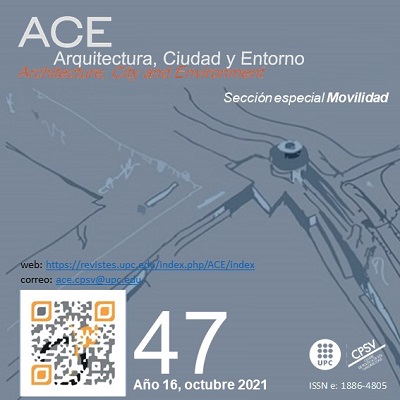Comprendre el rendiment dels jardins verticals mitjançant l'ús de la simulació d'edificis i les influències que tenen en el paisatge urbà
DOI:
https://doi.org/10.5821/ace.16.47.10321Paraules clau:
Façana verda, simulació d'edificis, consum d'energia, paisatge urbàResum
El desenvolupament urbà pot tenir un impacte profund en la salut i el benestar de les persones, la sostenibilitat de les ciutats, l'augment del consum d'energia a causa de l'augment de l'illa de calor urbana (UHI) i també el CO2, que és una de les preocupacions ambientals i socials. En aquest treball ha estat analitzat el jardí vertical com a segona pell a la façana, es comparen utilitzant diverses alternatives constructives de forma natural i sostenible. La proposta principal d'aquest estudi és una segona pell (façana verda) en un edifici d'oficines a Barcelona (Espanya) que es troba en orientació sud-oest, que té com a objectiu reduir al màxim el consum energètic i també millorar el paisatge urbà. Els jardins verticals, com a segona pell, s'implementen als murs exteriors de l'edifici per interceptar una quantitat de radiació solar cap a l'envolupant vertical de l'edifici. La metodologia es basa en l'avaluació de diverses opcions de façanes verdes mitjançant la simulació de les diferents mides de la profunditat, l'orientació i l'alçada de la cavitat de l'edifici. D'acord amb el resultat de la simulació obtingut d'Autodesk Green Building Studio, la profunditat de la cavitat de la façana verda com a segona pell és molt efectiva. La profunditat de cavitat s'ha de calcular segons allò especificat pel material de la façana principal de l'edifici i estructura, orientació de l'edifici, altura de l'edifici i clima. Aquest article presenta un cas d‟estudi que aplica aquest enfocament en un edifici d‟oficines ubicat a Passeig de Gràcia, zona de l'Eixample a Barcelona.
Descàrregues
Publicades
Número
Secció
Llicència
| CRITERIS DE PROTECCIÓ INTEL·LECTUAL |
En aquest moment es compta amb la protecció de la Oficina Espanyola de Patents i Marques, mentre que la protecció global s'està tramitant davant la Organització Mundial de la Propietat Intel·lectual (OMPI/WIPO). Així mateix, la Oficina del Número de Sèrie Estàndar Internacional (ISSN) ha otorgat els següents números: 1886-4805 (versió electrònica) i 1887-7052 (versió en paper). |
| COPYRIGHT |
El contingut dels articles i els comentaris en ells expresats són responsabilitat exclusiva dels seus actors, i no reflexen necessariament la opinió del Comité Editor de la revista. Els treballs publicats per ACE queden sotmesos a la llicència CC BY-NC-ND 3.0 ES http://creativecommons.org/licenses/by-nc-nd/3.0/es/ La qual cosa vol dir que les persones autores només tenen i retenen els drets d'autor dintre de les limitacions imposades per la anterior llicència |





































